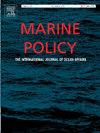Marine strategy framework directive: A comprehensive cost assessment for the Italian seas
IF 3.7
2区 社会学
Q2 ENVIRONMENTAL STUDIES
引用次数: 0
Abstract
In 2008, the EU launched the Marine Strategy Framework Directive (MSFD) to protect European waters and achieve Good Environmental Status (GES) of marine ecosystems. The implementation of the strategy requires Member States to assess the costs associated with the realization of MSFD measures to determine their feasibility and cost-effectiveness. Here we conducted a comprehensive analysis along 8300 km of the Italian coastline, to provide a cost analysis of the 23 new measures proposed for the second cycle of MSFD implementation in Italy. We used “unit-transfer” methodology to estimate the costs of each measure, grouping them into three categories: a) prevention, b) management, and c) monitoring and control. The “management” group included 12 measures and accounted for 65 % of total costs, followed by the “monitoring and control” group (5 measures, 28 % of total costs) and the “prevention” group (5 measures, 7 % of total costs). One measure had a double goal, and its implementation was attributed both to “prevention” and “monitoring and control”. The cost of implementing all the measures in Italy is approximately € 1.5 billion (∼0.07 % of Italian GDP in 2023). These results provide, for the first time, comprehensive and detailed quantitative information useful for policy makers to enable efficient financial planning for future actions required to achieve the GES in marine ecosystems. The approach developed here could also serve as a standard framework for assessing the costs of future measures under the MSFD, providing a benchmark or a methodological term of reference for all interested EU Member States.
海洋战略框架指令:意大利海洋综合费用评估
2008年,欧盟启动了海洋战略框架指令(MSFD),以保护欧洲水域并实现海洋生态系统的良好环境状态(GES)。该战略的执行要求会员国评估与实现MSFD措施有关的费用,以确定其可行性和成本效益。在这里,我们对意大利8300 公里的海岸线进行了全面分析,对意大利实施MSFD第二周期提出的23项新措施进行了成本分析。我们使用“单位转移”方法来估计每项措施的成本,并将其分为三类:a)预防,b)管理,c)监测和控制。“管理”组包括12项措施,占总成本的65% %,其次是“监测和控制”组(5项措施,占总成本的28% %)和“预防”组(5项措施,占总成本的7% %)。有一项措施具有双重目标,其实施被认为是“预防”和“监测和控制”。在意大利实施所有措施的成本约为15亿欧元(2023年意大利GDP的0.07% %)。这些结果首次为决策者提供了全面和详细的定量信息,有助于他们为实现海洋生态系统全球生态系统目标所需的未来行动进行有效的财务规划。这里制定的方法也可以作为评估MSFD下未来措施成本的标准框架,为所有感兴趣的欧盟成员国提供基准或方法上的职权范围。
本文章由计算机程序翻译,如有差异,请以英文原文为准。
求助全文
约1分钟内获得全文
求助全文
来源期刊

Marine Policy
Multiple-
CiteScore
7.60
自引率
13.20%
发文量
428
期刊介绍:
Marine Policy is the leading journal of ocean policy studies. It offers researchers, analysts and policy makers a unique combination of analyses in the principal social science disciplines relevant to the formulation of marine policy. Major articles are contributed by specialists in marine affairs, including marine economists and marine resource managers, political scientists, marine scientists, international lawyers, geographers and anthropologists. Drawing on their expertise and research, the journal covers: international, regional and national marine policies; institutional arrangements for the management and regulation of marine activities, including fisheries and shipping; conflict resolution; marine pollution and environment; conservation and use of marine resources. Regular features of Marine Policy include research reports, conference reports and reports on current developments to keep readers up-to-date with the latest developments and research in ocean affairs.
 求助内容:
求助内容: 应助结果提醒方式:
应助结果提醒方式:


